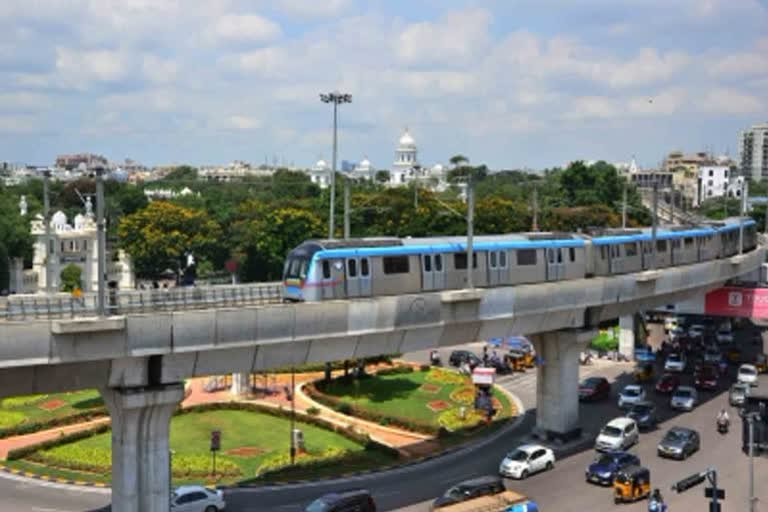New Delhi: The running of metro trains in different cities across India have not only decreased pollution level but has also registered a reduction in fuel consumption. The latest report of the Parliamentary Committee on Housing and Urban Affairs has said that the running of metro trains has registered economic, social, and environmental benefits.
Quoting Delhi Metro Rail Corporation (DMRC) report, the Ministry of Housing and Urban Affairs (MoHUA), has told the Parliamentary Committee that the metro study carried out by The Energy and Resources Institute has established that Delhi Metro helps in taking the load of 4,74,134 vehicles off the roads daily. “This in turn reduces traffic congestion, pollution, savings in travel time, etc,” the Ministry said.
According to the report, the annual reduction in fuel consumption was 2,33,000. It has also recorded an annual reduction in pollution up to 7,11,396 tons. The study was conducted in 2018-19 by The Energy and Resources Institute (TERI) to identify the economic, social, and environmental benefits on account of the Delhi Metro up to the commissioning of Phase III.
The Uttar Pradesh Metro Rail Corporation Limited (UPMRCL) has also conducted a pre-monsoon 2019 survey by CSIR- Indian Institute of Toxicology Research for “Assessment of Ambient Air Quality of Lucknow City”. It was found that some portions of Lucknow city that have a convenient metro system, had a significant impact on city air pollution positively by avoiding road transportation.
“Overall results indicate that all the parameters monitored showed a slightly decreasing trend which might be due to full-fledged operation of metro rails, cleanliness of roadside areas,” the MoHUA said, quoting the UPMRCL report.
Significantly, the Bangalore Metro has also appointed Bangalore University to prepare an Environmental Monitoring report every Quarter to assess the impact of the Eco-friendly Metro rail project on reducing pollution.
Average Daily Ridership:
Delhi Metro: Actual Average Daily Ridership (AADR) of Delhi Metro was 26.14, 28.00, 25.86, 25.93, and 50.65 lakhs in 2015-16, 2016-17, 2017-18, 2018-19, and 2019-20 against the average daily ridership required for breakeven of 16.07, 18.59, 16.26, 17.03 and 38.24 lakhs, respectively, in the same years. The breakeven covers the operating expenses (Energy, Salaries & wages Maintenance & other costs).
Bengaluru Metro: Actual Average Daily Ridership (AADR) of Bengaluru metro was 1.48, 3.40, 4.52, 4.89, and 0.96 lakhs only in 2016-17, 2017-18, 2018-19, 2019-20, and 2020-21 against average daily ridership required for breakeven of 7.65, 10.09, 12.32, 13.19 and 18.54 lakhs.
Hyderabad Metro: Actual Average Daily Ridership (AADR) of Hyderabad metro was 0.67, 1.26, 2.76, and 0.65 lakhs in 2017-18, 2018-19, 2019-20 and 2020-21 against the average daily ridership required for breakeven of 19.00 lakhs for all these years.
Lucknow Metro: Actual Average Daily Ridership (AADR) of Lucknow metro was 0.537, and 0.258 lakhs only in 2019-20 and 2020-21 against the average daily ridership required for breakeven of 0.943 lakhs for all these years. Thus Lucknow metro also does not have sufficient ridership for breakeven.
Also Read: Delhi Metro trains start running with 100 pc seating capacity; standing not allowed in coaches
Chennai Metro: Actual Average Daily Ridership (AADR) of Chennai metro was 10,923, 23,301, 50,312, 92,000 and 45,393 in 2016-17, 2017-18, 2018-19, 2019-20 and 2020-21 against average daily ridership required for breakeven is 92209, 108694, 204903, 253989 and 433644 for all these years.
Kolkata Metro had Actual Average Daily Ridership of 5.40 to 5.84 lakhs only in Pre Covid times against 15 lakhs required for Breakeven. Thus, actual ridership is merely one-third (approx) of the ridership required for breakeven.
Kochi Metro: Actual Average Daily Ridership (AADR) of Kochi metro was 0.35, 0.35, 0.51, and 0.19 lakhs in 2017-18, 2018-19, 2019-20 and 2020-21 against the average daily ridership required for breakeven of 0.59, 0.40, 0.64, and 1 lakh, respectively, in the same years.
Ahmedabad Metro: For an operational network of 6.15 km (so far) the Actual Average Daily Ridership (AADR) is 415.
Jaipur metro: Actual Average Daily Ridership Jaipur metro was 27214, 19789, 16891, 19671, 19292, and 9375 in 2015-16, 2016-17, 2017-18, 2018-19, 2019-20, and 2020-21 against the average daily ridership required for breakeven of 90049, 90032, 76906, 95336, 84008 and 103287.
Mumbai Line-1 had Actual Average Daily Ridership of 2.86 lakh to 3.67 lakh in the last five years against the average daily ridership required for breakeven of 1.75 lakh, barring the covid year. Thus, it has been getting more ridership than required for breakeven.



